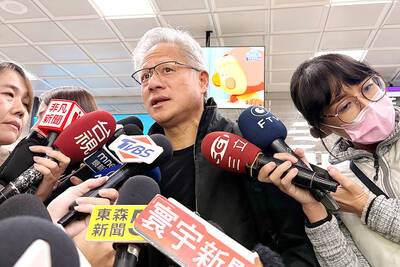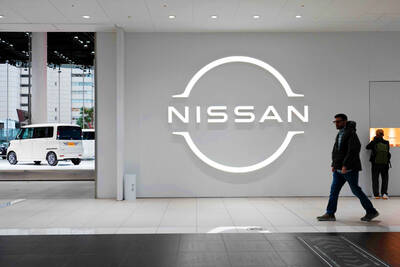Taiwan’s GDP is forecast to expand 5.6 percent this year, faster than a 3.1 percent increase last year, driven by strong global demand for semiconductors, aggressive private investment by local tech firms and an expected recovery in consumer spending, S&P Global Ratings said yesterday.
Improving external demand and COVID-19 curbs would lend support to credit profiles across economic sectors, even though their paces of recovery vary, said the agency’s local arm, Taiwan Ratings Corp (中華信評).
The nation’s economic growth is closely tied to the recovery in the Asia-Pacific region and the world as a whole, S&P said, predicting that economic stimulus programs in the US and growing global demand for technology products would continue to fuel strong recovery in the region and Taiwan’s exports for the rest of this year.
COVID-19 vaccine rollouts might be off to a slow start in the region, but a gradual catch-up in vaccine coverage would lift consumer confidence and spending later this year or next year, it said.
Taiwan would follow a trajectory similar to its regional peers, S&P said, adding that consumer activity in the nation is taking a hard hit from a local outbreak of COVID-19.
Taiwan’s export-oriented economy, despite its bright outlook, remains susceptible to global and regional shocks, as well as domestic risks, it said.
Risks include the threat of a worsening COVID-19 situation and government control measures such as abrupt lockdowns or tight social distancing requirements, it said.
Draconian measures by different nations to combat the pandemic could derail the region’s economic recovery, and shrink demand for Taiwan’s goods and services, S&P said.
In addition, escalating tension between the US and China could weigh on Taiwan, especially its technology access, it said.
Taiwanese firms have thus far showed signs of an uneven revenue recovery, accompanied by mounting leverage, foreign exchange rate swings, volatile commodity prices, and the possibility of water and power shortages, S&P said.
Credit ratios for most sectors are unlikely to return to pre-pandemic levels until the second half of next year, it said.
However, active investment in information technology and 5G infrastructure, as well as stable construction demand, would boost credit metrics in the high-tech, cement and steel sectors, it said.
As a result, firms in the retail, telecom and technology sectors would lead the recovery, while companies in the aviation, oil, gas and automotive sectors would lag behind, it said.
Soaring shipping freight rates would more than offset elevated operating costs and bolster credit profiles for the container shipping sector, S&P said.
Airlines would face a protracted recovery due to a stalled passenger increase, despite strong demand, it said.
Adequate-to-strong capitalization and abundant liquidity would buttress credit profiles in the banking sector and help lenders cushion against a potential rise in credit costs as the pandemic persists, it said.
Insurers continue to face flat recurring yields and foreign exchange risks, but strong trading gains help support capitalization, aided by a rebound in equity valuation and adequate risk controls, S&P said.

PERSISTENT RUMORS: Nvidia’s CEO said the firm is not in talks to sell AI chips to China, but he would welcome a change in US policy barring the activity Nvidia Corp CEO Jensen Huang (黃仁勳) said his company is not in discussions to sell its Blackwell artificial intelligence (AI) chips to Chinese firms, waving off speculation it is trying to engineer a return to the world’s largest semiconductor market. Huang, who arrived in Taiwan yesterday ahead of meetings with longtime partner Taiwan Semiconductor Manufacturing Co (TSMC, 台積電), took the opportunity to clarify recent comments about the US-China AI race. The Nvidia head caused a stir in an interview this week with the Financial Times, in which he was quoted as saying “China will win” the AI race. Huang yesterday said

Nissan Motor Co has agreed to sell its global headquarters in Yokohama for ¥97 billion (US$630 million) to a group sponsored by Taiwanese autoparts maker Minth Group (敏實集團), as the struggling automaker seeks to shore up its financial position. The acquisition is led by a special purchase company managed by KJR Management Ltd, a Japanese real-estate unit of private equity giant KKR & Co, people familiar with the matter said. KJR said it would act as asset manager together with Mizuho Real Estate Management Co. Nissan is undergoing a broad cost-cutting campaign by eliminating jobs and shuttering plants as it grapples

The Chinese government has issued guidance requiring new data center projects that have received any state funds to only use domestically made artificial intelligence (AI) chips, two sources familiar with the matter told Reuters. In recent weeks, Chinese regulatory authorities have ordered such data centers that are less than 30 percent complete to remove all installed foreign chips, or cancel plans to purchase them, while projects in a more advanced stage would be decided on a case-by-case basis, the sources said. The move could represent one of China’s most aggressive steps yet to eliminate foreign technology from its critical infrastructure amid a

MORE WEIGHT: The national weighting was raised in one index while holding steady in two others, while several companies rose or fell in prominence MSCI Inc, a global index provider, has raised Taiwan’s weighting in one of its major indices and left the country’s weighting unchanged in two other indices after a regular index review. In a statement released on Thursday, MSCI said it has upgraded Taiwan’s weighting in the MSCI All-Country World Index by 0.02 percentage points to 2.25 percent, while maintaining the weighting in the MSCI Emerging Markets Index, the most closely watched by foreign institutional investors, at 20.46 percent. Additionally, the index provider has left Taiwan’s weighting in the MSCI All-Country Asia ex-Japan Index unchanged at 23.15 percent. The latest index adjustments are to